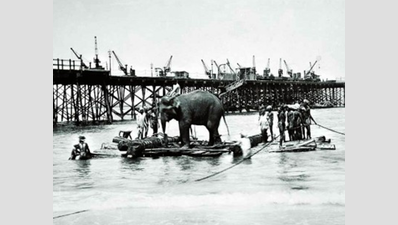- News
- City News
- chennai News
- When elephants were on payroll of Indian Railways
Trending
This story is from August 25, 2019
When elephants were on payroll of Indian Railways
For a city that had no native elephants, with in 200 miles, Madras has a long and interesting history of pachyderm chronicles, according to historian and novelist Venkatesh Ramakrishnan.

CHENNAI: For a city that had no native elephants, with in 200 miles, Madras has a long and interesting history of pachyderm chronicles, according to historian and novelist Venkatesh Ramakrishnan. “The British brought elephants to Madras though there might have been an odd one in Cholas or Vijaynagar times. Elephants were there during the Pallava reign as they are depicted in the art and history,” he said, while speaking on “Elephants in Madras” at CPR Institute of Indological Research in the city on Saturday.
Why did the British bring elephants to Madras, as the forest in the presidency had elephants in abundance? “The English East India company’s trade to the South East Asia from the Coromandel coast consisted mainly of the export of textile goods.In return, elephants featured as the most sought valuable item for the English to be sold among the local rulers in Coromandel coast. Hundreds of elephants were shipped every year from Peru, Tenasserim and Malacca, where they were found in abundance,” he said.
Why did the British trap elephants from the forests here? There is a reason behind it. “The company did try trapping elephants from Indian forests, but it felt hunting Indian elephants was too expensive as many died in captivity. Importing elephants from far east was more profitable,” he said. There was no harbour in Madras and the elephants were pushed into the sea and made to swim more than two km. Later, the elephants landed via a raft from a ship stationed two miles away from the shore.
Venkatesh said during the World War II, several engines of the Indian railway were shipped to Mesopotamia and other places where the British thought they were more in need to serve wartime logistics. “Indian railways had exactly as many engines as they needed to pull the trains. The surplus used for shunting carriages and loads were performed by the elephants. Many elephants were on the payroll of the railways,” he said. “In early 1900’s, there was a fixed ticket for elephants in south Indian railway. If a passenger wanted his elephant to accompany him the ticket would cost a hefty Rs 600,” he added.
Why did the British bring elephants to Madras, as the forest in the presidency had elephants in abundance? “The English East India company’s trade to the South East Asia from the Coromandel coast consisted mainly of the export of textile goods.In return, elephants featured as the most sought valuable item for the English to be sold among the local rulers in Coromandel coast. Hundreds of elephants were shipped every year from Peru, Tenasserim and Malacca, where they were found in abundance,” he said.
Why did the British trap elephants from the forests here? There is a reason behind it. “The company did try trapping elephants from Indian forests, but it felt hunting Indian elephants was too expensive as many died in captivity. Importing elephants from far east was more profitable,” he said. There was no harbour in Madras and the elephants were pushed into the sea and made to swim more than two km. Later, the elephants landed via a raft from a ship stationed two miles away from the shore.
Venkatesh said during the World War II, several engines of the Indian railway were shipped to Mesopotamia and other places where the British thought they were more in need to serve wartime logistics. “Indian railways had exactly as many engines as they needed to pull the trains. The surplus used for shunting carriages and loads were performed by the elephants. Many elephants were on the payroll of the railways,” he said. “In early 1900’s, there was a fixed ticket for elephants in south Indian railway. If a passenger wanted his elephant to accompany him the ticket would cost a hefty Rs 600,” he added.
Elephants also brought in bad news. “Many people were stamped or kicked by the disturbed elephants in a concrete jungle. The nationalistic poet Bharathi, who was out to feed an elephant in the Parthasarathy temple, was knocked down by it. He died a few weeks later. Despite the tragedies, elephants have added much colour to the city,” said Venkatesh.
End of Article
FOLLOW US ON SOCIAL MEDIA










